Organisational Strategy and Leadership for Aldi Australia
VerifiedAdded on 2023/06/13
|21
|5542
|277
AI Summary
This study analyzes the external environment and industry analysis of Aldi Australia, a German-based multinational company that has redefined the market competition with its cost-effective business model. The study includes a PESTLE analysis, industry analysis, and factors driving the industry towards a change. The purpose of this study is to communicate the knowledge related to strategic planning.
Contribute Materials
Your contribution can guide someone’s learning journey. Share your
documents today.

Running head: ORGANIZATIONAL STRATEGY AND LEADERSHIP
Organisational Strategy and Leadership
[Aldi Australia]
Name of the student:
Name of the university:
Author note:
Organisational Strategy and Leadership
[Aldi Australia]
Name of the student:
Name of the university:
Author note:
Secure Best Marks with AI Grader
Need help grading? Try our AI Grader for instant feedback on your assignments.
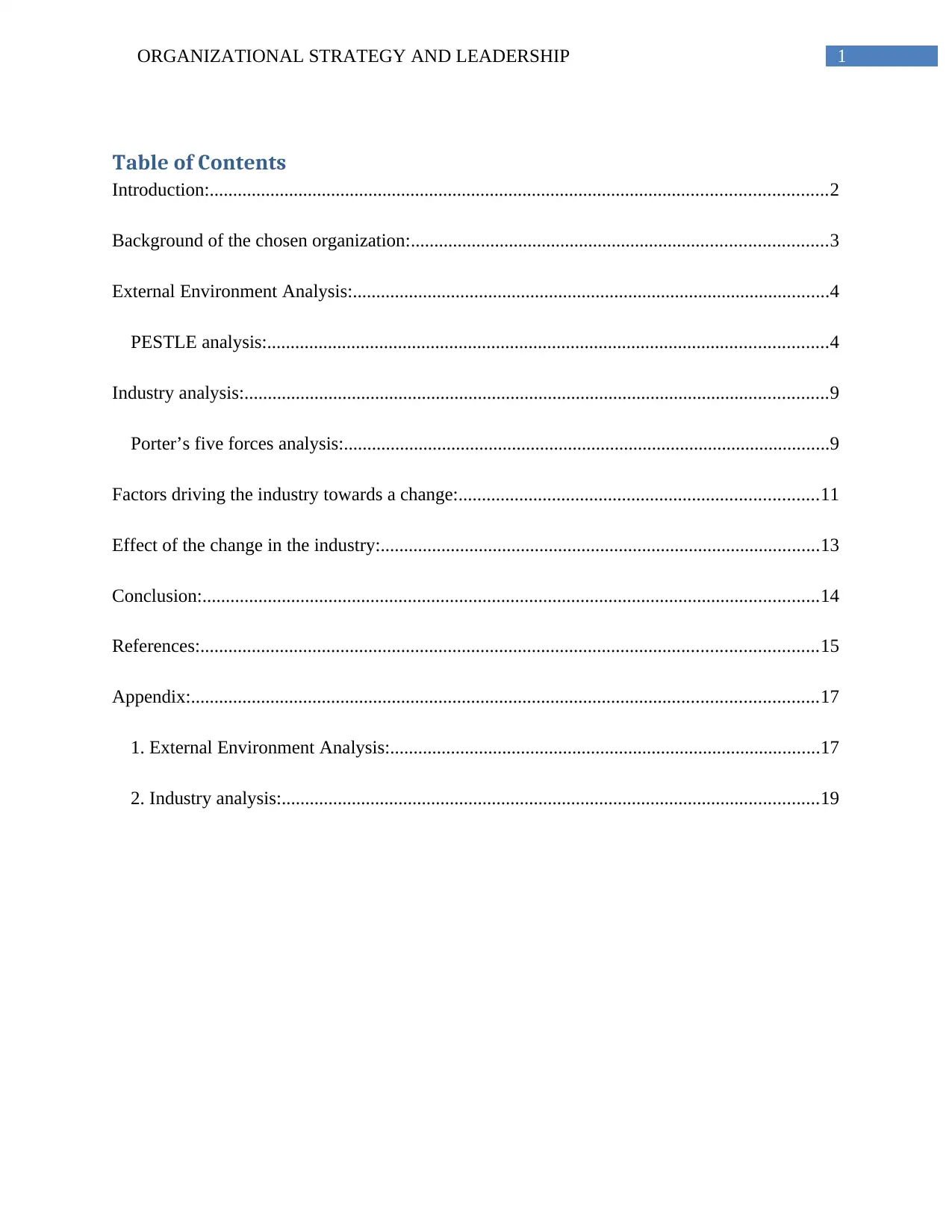
1ORGANIZATIONAL STRATEGY AND LEADERSHIP
Table of Contents
Introduction:....................................................................................................................................2
Background of the chosen organization:.........................................................................................3
External Environment Analysis:......................................................................................................4
PESTLE analysis:........................................................................................................................4
Industry analysis:.............................................................................................................................9
Porter’s five forces analysis:........................................................................................................9
Factors driving the industry towards a change:.............................................................................11
Effect of the change in the industry:..............................................................................................13
Conclusion:....................................................................................................................................14
References:....................................................................................................................................15
Appendix:......................................................................................................................................17
1. External Environment Analysis:............................................................................................17
2. Industry analysis:...................................................................................................................19
Table of Contents
Introduction:....................................................................................................................................2
Background of the chosen organization:.........................................................................................3
External Environment Analysis:......................................................................................................4
PESTLE analysis:........................................................................................................................4
Industry analysis:.............................................................................................................................9
Porter’s five forces analysis:........................................................................................................9
Factors driving the industry towards a change:.............................................................................11
Effect of the change in the industry:..............................................................................................13
Conclusion:....................................................................................................................................14
References:....................................................................................................................................15
Appendix:......................................................................................................................................17
1. External Environment Analysis:............................................................................................17
2. Industry analysis:...................................................................................................................19
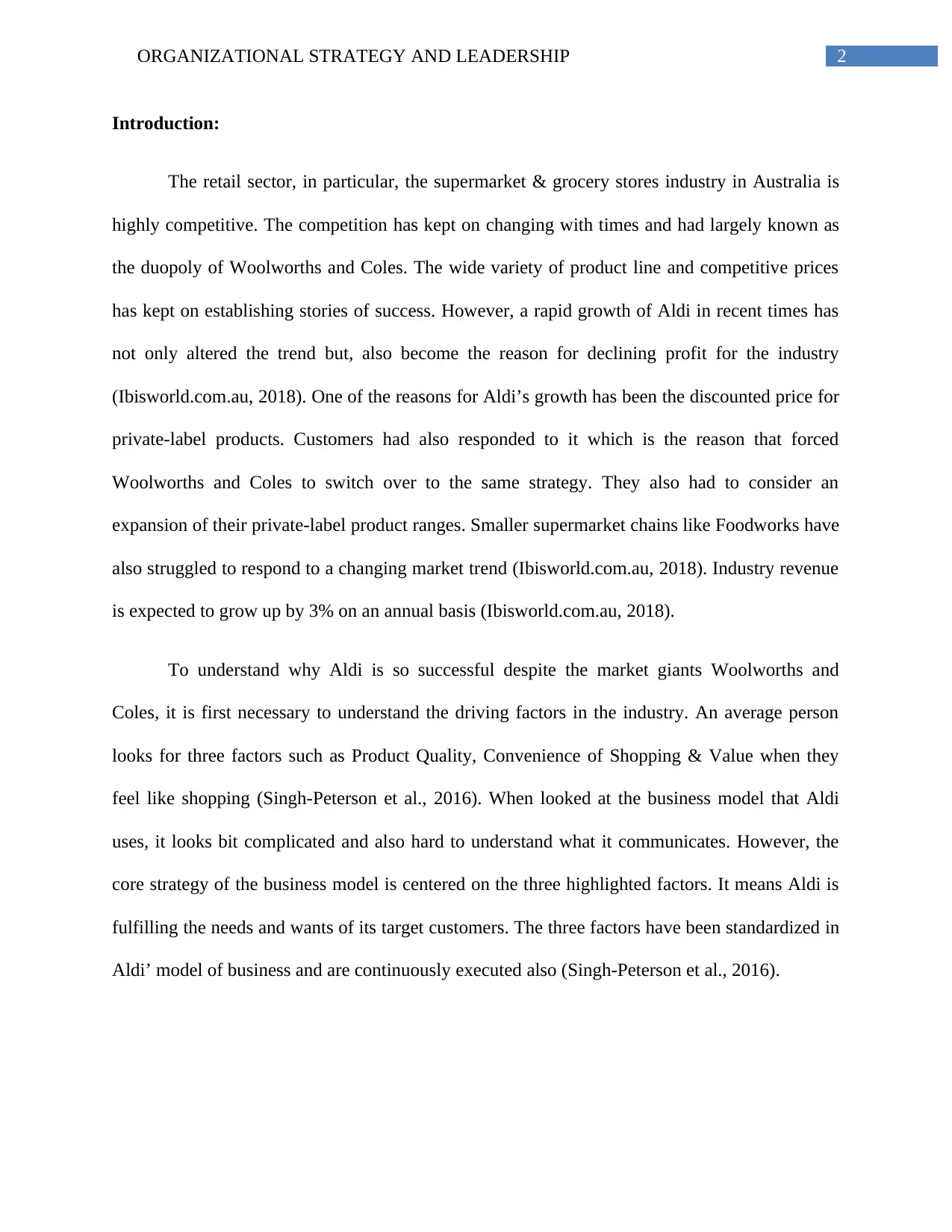
2ORGANIZATIONAL STRATEGY AND LEADERSHIP
Introduction:
The retail sector, in particular, the supermarket & grocery stores industry in Australia is
highly competitive. The competition has kept on changing with times and had largely known as
the duopoly of Woolworths and Coles. The wide variety of product line and competitive prices
has kept on establishing stories of success. However, a rapid growth of Aldi in recent times has
not only altered the trend but, also become the reason for declining profit for the industry
(Ibisworld.com.au, 2018). One of the reasons for Aldi’s growth has been the discounted price for
private-label products. Customers had also responded to it which is the reason that forced
Woolworths and Coles to switch over to the same strategy. They also had to consider an
expansion of their private-label product ranges. Smaller supermarket chains like Foodworks have
also struggled to respond to a changing market trend (Ibisworld.com.au, 2018). Industry revenue
is expected to grow up by 3% on an annual basis (Ibisworld.com.au, 2018).
To understand why Aldi is so successful despite the market giants Woolworths and
Coles, it is first necessary to understand the driving factors in the industry. An average person
looks for three factors such as Product Quality, Convenience of Shopping & Value when they
feel like shopping (Singh-Peterson et al., 2016). When looked at the business model that Aldi
uses, it looks bit complicated and also hard to understand what it communicates. However, the
core strategy of the business model is centered on the three highlighted factors. It means Aldi is
fulfilling the needs and wants of its target customers. The three factors have been standardized in
Aldi’ model of business and are continuously executed also (Singh-Peterson et al., 2016).
Introduction:
The retail sector, in particular, the supermarket & grocery stores industry in Australia is
highly competitive. The competition has kept on changing with times and had largely known as
the duopoly of Woolworths and Coles. The wide variety of product line and competitive prices
has kept on establishing stories of success. However, a rapid growth of Aldi in recent times has
not only altered the trend but, also become the reason for declining profit for the industry
(Ibisworld.com.au, 2018). One of the reasons for Aldi’s growth has been the discounted price for
private-label products. Customers had also responded to it which is the reason that forced
Woolworths and Coles to switch over to the same strategy. They also had to consider an
expansion of their private-label product ranges. Smaller supermarket chains like Foodworks have
also struggled to respond to a changing market trend (Ibisworld.com.au, 2018). Industry revenue
is expected to grow up by 3% on an annual basis (Ibisworld.com.au, 2018).
To understand why Aldi is so successful despite the market giants Woolworths and
Coles, it is first necessary to understand the driving factors in the industry. An average person
looks for three factors such as Product Quality, Convenience of Shopping & Value when they
feel like shopping (Singh-Peterson et al., 2016). When looked at the business model that Aldi
uses, it looks bit complicated and also hard to understand what it communicates. However, the
core strategy of the business model is centered on the three highlighted factors. It means Aldi is
fulfilling the needs and wants of its target customers. The three factors have been standardized in
Aldi’ model of business and are continuously executed also (Singh-Peterson et al., 2016).

3ORGANIZATIONAL STRATEGY AND LEADERSHIP
The purpose of this study is to communicate the knowledge related to strategic planning.
The purpose is being served in various ways including the external environment analysis and
also the industry analysis.
Background of the chosen organization:
Aldi is a German based multinational company and had entered Australia in 2001. The
company had its first store in Sydney and since then has kept on growing with its effective
business strategies. However, the excellent performance was noticed in just the last five years.
The company has redefined the market competition with its cost-effective business model. It has
constantly executed the three essential elements of customer needs such as quality, value and
convenience (Knox, 2015). The execution could be possible due to its cost-effective strategies.
Cost-effectiveness was a result of constant strategic planning that also includes maintaining a
lesser number of SKU’s (Stock Keeping Unit). The benefits of the strategy include lower cost of
handling and also higher purchasing power. Exclusive brands of Aldi are accountable for
approximately 90% of their shelf space. Hence, Aldi is able to cut down on the supply prices.
These are few of the reasons how the company has managed to keep the cost of production lower
(Arup, Beaton-Wells & Paul-Taylor, 2017).
Limited range of products was being maintained to focus more on a quality product. The
efficient handling of the production cost was actually reinvested in offering lower prices to
customers. The choice is actually not a very high concern to many customers. There are
customers that prefer getting the reduced range of quality products at competitive price range
over a wide range of expensive and low-quality products. Convenience was maintained with the
help of opening numbers of branches in the different parts of Australia. The expansion rate is
The purpose of this study is to communicate the knowledge related to strategic planning.
The purpose is being served in various ways including the external environment analysis and
also the industry analysis.
Background of the chosen organization:
Aldi is a German based multinational company and had entered Australia in 2001. The
company had its first store in Sydney and since then has kept on growing with its effective
business strategies. However, the excellent performance was noticed in just the last five years.
The company has redefined the market competition with its cost-effective business model. It has
constantly executed the three essential elements of customer needs such as quality, value and
convenience (Knox, 2015). The execution could be possible due to its cost-effective strategies.
Cost-effectiveness was a result of constant strategic planning that also includes maintaining a
lesser number of SKU’s (Stock Keeping Unit). The benefits of the strategy include lower cost of
handling and also higher purchasing power. Exclusive brands of Aldi are accountable for
approximately 90% of their shelf space. Hence, Aldi is able to cut down on the supply prices.
These are few of the reasons how the company has managed to keep the cost of production lower
(Arup, Beaton-Wells & Paul-Taylor, 2017).
Limited range of products was being maintained to focus more on a quality product. The
efficient handling of the production cost was actually reinvested in offering lower prices to
customers. The choice is actually not a very high concern to many customers. There are
customers that prefer getting the reduced range of quality products at competitive price range
over a wide range of expensive and low-quality products. Convenience was maintained with the
help of opening numbers of branches in the different parts of Australia. The expansion rate is
Secure Best Marks with AI Grader
Need help grading? Try our AI Grader for instant feedback on your assignments.

4ORGANIZATIONAL STRATEGY AND LEADERSHIP
appreciable indeed (Corones, 2015). The store layout is another reason why Aldi is able to cut
down on the cost of production. Stores are not open for 24 hours. It helps to save on staffing
costs and utility expenses. The number of employees has also been kept low. Employees are
trained on multi-skills to support their strategy of keeping a low number of employees. Products
are all packaged and hence, it helps to reduce the shelf stocking time of products (Corones,
2015). The checkout process is also very competitive. Customers are encouraged to bring their
carrier bags to avoid unnecessary expenses being made on it. The check-out lines are supported
with long belts. Hence, accommodating a large number of products which is also necessary to
cut down the queues gathered around the place. Packaged products have a barcode in more than
one place supporting an efficient check-out process. Customers are encouraged also to package
their goods. It helps to cut down the time and also the expenses which could have been required
for keeping staffs particularly for packaging (Medlin & Ellegaard, 2015).
External Environment Analysis:
PESTLE analysis:
Political:
The Australian retail grocery sectors have been a point of attraction for the public body
and the critique experts. The competitions have been redefined with the effective strategies of
Aldi which is always good for customers; however, not so for the country's economy. In course
to offer the competitive prices, the supermarket stores have considered being low with their net
profit. Such trend has affected the annual growth of the grocery and the supermarket industry in
Australia. As reported by the IBISWorld, the industry is expected to grow at 3% annually
(Ibisworld.com.au, 2018). Initially, the duopoly of Coles and Woolworths was the reason for
appreciable indeed (Corones, 2015). The store layout is another reason why Aldi is able to cut
down on the cost of production. Stores are not open for 24 hours. It helps to save on staffing
costs and utility expenses. The number of employees has also been kept low. Employees are
trained on multi-skills to support their strategy of keeping a low number of employees. Products
are all packaged and hence, it helps to reduce the shelf stocking time of products (Corones,
2015). The checkout process is also very competitive. Customers are encouraged to bring their
carrier bags to avoid unnecessary expenses being made on it. The check-out lines are supported
with long belts. Hence, accommodating a large number of products which is also necessary to
cut down the queues gathered around the place. Packaged products have a barcode in more than
one place supporting an efficient check-out process. Customers are encouraged also to package
their goods. It helps to cut down the time and also the expenses which could have been required
for keeping staffs particularly for packaging (Medlin & Ellegaard, 2015).
External Environment Analysis:
PESTLE analysis:
Political:
The Australian retail grocery sectors have been a point of attraction for the public body
and the critique experts. The competitions have been redefined with the effective strategies of
Aldi which is always good for customers; however, not so for the country's economy. In course
to offer the competitive prices, the supermarket stores have considered being low with their net
profit. Such trend has affected the annual growth of the grocery and the supermarket industry in
Australia. As reported by the IBISWorld, the industry is expected to grow at 3% annually
(Ibisworld.com.au, 2018). Initially, the duopoly of Coles and Woolworths was the reason for
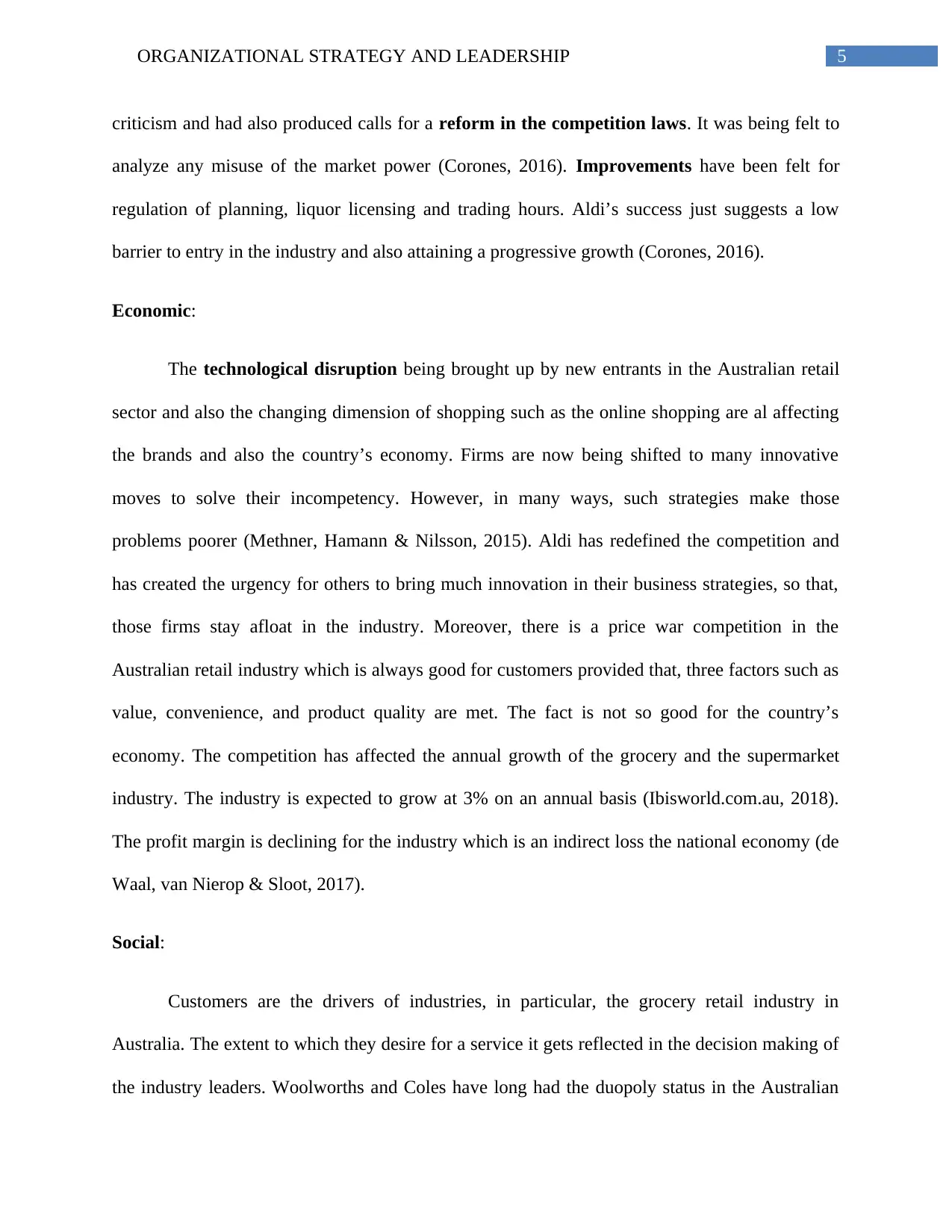
5ORGANIZATIONAL STRATEGY AND LEADERSHIP
criticism and had also produced calls for a reform in the competition laws. It was being felt to
analyze any misuse of the market power (Corones, 2016). Improvements have been felt for
regulation of planning, liquor licensing and trading hours. Aldi’s success just suggests a low
barrier to entry in the industry and also attaining a progressive growth (Corones, 2016).
Economic:
The technological disruption being brought up by new entrants in the Australian retail
sector and also the changing dimension of shopping such as the online shopping are al affecting
the brands and also the country’s economy. Firms are now being shifted to many innovative
moves to solve their incompetency. However, in many ways, such strategies make those
problems poorer (Methner, Hamann & Nilsson, 2015). Aldi has redefined the competition and
has created the urgency for others to bring much innovation in their business strategies, so that,
those firms stay afloat in the industry. Moreover, there is a price war competition in the
Australian retail industry which is always good for customers provided that, three factors such as
value, convenience, and product quality are met. The fact is not so good for the country’s
economy. The competition has affected the annual growth of the grocery and the supermarket
industry. The industry is expected to grow at 3% on an annual basis (Ibisworld.com.au, 2018).
The profit margin is declining for the industry which is an indirect loss the national economy (de
Waal, van Nierop & Sloot, 2017).
Social:
Customers are the drivers of industries, in particular, the grocery retail industry in
Australia. The extent to which they desire for a service it gets reflected in the decision making of
the industry leaders. Woolworths and Coles have long had the duopoly status in the Australian
criticism and had also produced calls for a reform in the competition laws. It was being felt to
analyze any misuse of the market power (Corones, 2016). Improvements have been felt for
regulation of planning, liquor licensing and trading hours. Aldi’s success just suggests a low
barrier to entry in the industry and also attaining a progressive growth (Corones, 2016).
Economic:
The technological disruption being brought up by new entrants in the Australian retail
sector and also the changing dimension of shopping such as the online shopping are al affecting
the brands and also the country’s economy. Firms are now being shifted to many innovative
moves to solve their incompetency. However, in many ways, such strategies make those
problems poorer (Methner, Hamann & Nilsson, 2015). Aldi has redefined the competition and
has created the urgency for others to bring much innovation in their business strategies, so that,
those firms stay afloat in the industry. Moreover, there is a price war competition in the
Australian retail industry which is always good for customers provided that, three factors such as
value, convenience, and product quality are met. The fact is not so good for the country’s
economy. The competition has affected the annual growth of the grocery and the supermarket
industry. The industry is expected to grow at 3% on an annual basis (Ibisworld.com.au, 2018).
The profit margin is declining for the industry which is an indirect loss the national economy (de
Waal, van Nierop & Sloot, 2017).
Social:
Customers are the drivers of industries, in particular, the grocery retail industry in
Australia. The extent to which they desire for a service it gets reflected in the decision making of
the industry leaders. Woolworths and Coles have long had the duopoly status in the Australian
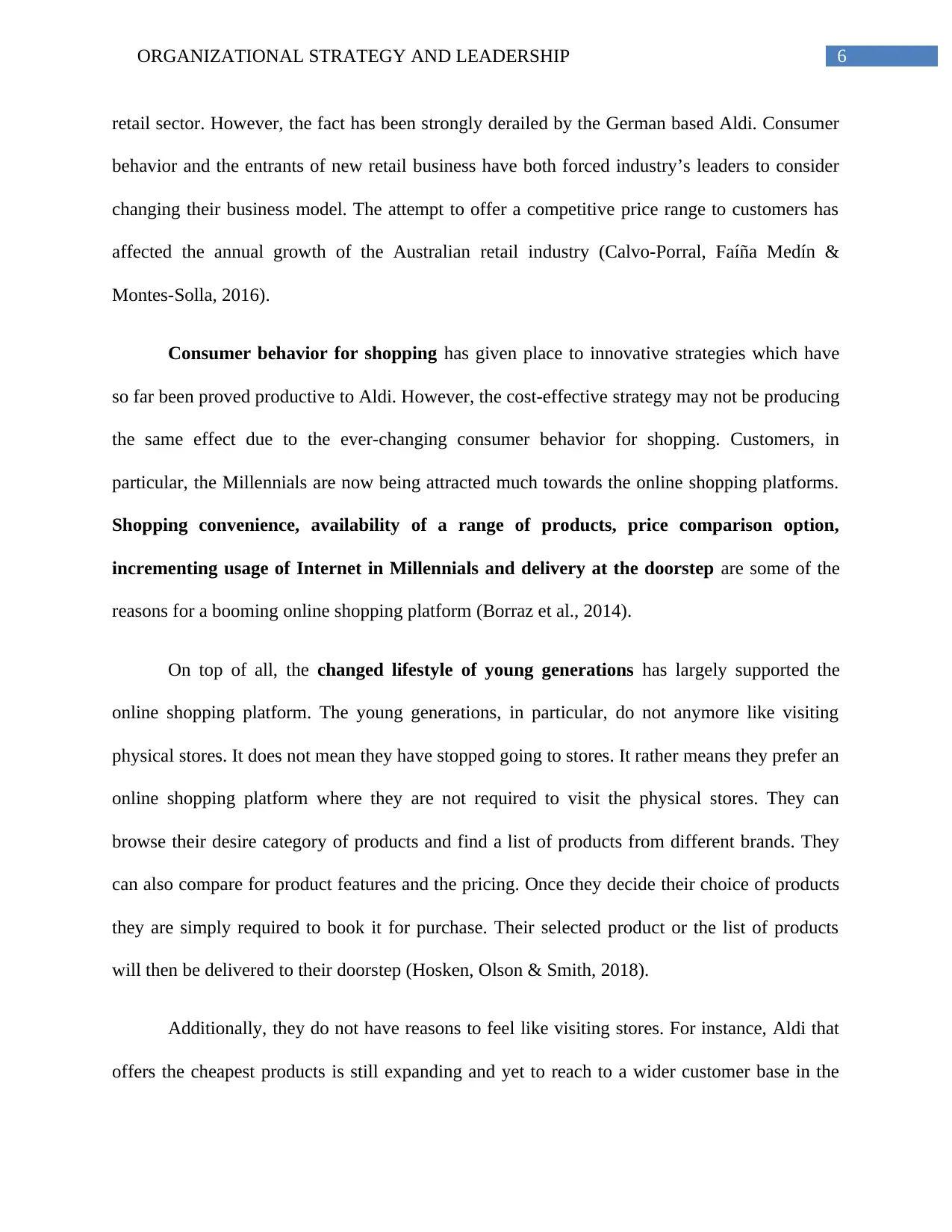
6ORGANIZATIONAL STRATEGY AND LEADERSHIP
retail sector. However, the fact has been strongly derailed by the German based Aldi. Consumer
behavior and the entrants of new retail business have both forced industry’s leaders to consider
changing their business model. The attempt to offer a competitive price range to customers has
affected the annual growth of the Australian retail industry (Calvo-Porral, Faíña Medín &
Montes-Solla, 2016).
Consumer behavior for shopping has given place to innovative strategies which have
so far been proved productive to Aldi. However, the cost-effective strategy may not be producing
the same effect due to the ever-changing consumer behavior for shopping. Customers, in
particular, the Millennials are now being attracted much towards the online shopping platforms.
Shopping convenience, availability of a range of products, price comparison option,
incrementing usage of Internet in Millennials and delivery at the doorstep are some of the
reasons for a booming online shopping platform (Borraz et al., 2014).
On top of all, the changed lifestyle of young generations has largely supported the
online shopping platform. The young generations, in particular, do not anymore like visiting
physical stores. It does not mean they have stopped going to stores. It rather means they prefer an
online shopping platform where they are not required to visit the physical stores. They can
browse their desire category of products and find a list of products from different brands. They
can also compare for product features and the pricing. Once they decide their choice of products
they are simply required to book it for purchase. Their selected product or the list of products
will then be delivered to their doorstep (Hosken, Olson & Smith, 2018).
Additionally, they do not have reasons to feel like visiting stores. For instance, Aldi that
offers the cheapest products is still expanding and yet to reach to a wider customer base in the
retail sector. However, the fact has been strongly derailed by the German based Aldi. Consumer
behavior and the entrants of new retail business have both forced industry’s leaders to consider
changing their business model. The attempt to offer a competitive price range to customers has
affected the annual growth of the Australian retail industry (Calvo-Porral, Faíña Medín &
Montes-Solla, 2016).
Consumer behavior for shopping has given place to innovative strategies which have
so far been proved productive to Aldi. However, the cost-effective strategy may not be producing
the same effect due to the ever-changing consumer behavior for shopping. Customers, in
particular, the Millennials are now being attracted much towards the online shopping platforms.
Shopping convenience, availability of a range of products, price comparison option,
incrementing usage of Internet in Millennials and delivery at the doorstep are some of the
reasons for a booming online shopping platform (Borraz et al., 2014).
On top of all, the changed lifestyle of young generations has largely supported the
online shopping platform. The young generations, in particular, do not anymore like visiting
physical stores. It does not mean they have stopped going to stores. It rather means they prefer an
online shopping platform where they are not required to visit the physical stores. They can
browse their desire category of products and find a list of products from different brands. They
can also compare for product features and the pricing. Once they decide their choice of products
they are simply required to book it for purchase. Their selected product or the list of products
will then be delivered to their doorstep (Hosken, Olson & Smith, 2018).
Additionally, they do not have reasons to feel like visiting stores. For instance, Aldi that
offers the cheapest products is still expanding and yet to reach to a wider customer base in the
Paraphrase This Document
Need a fresh take? Get an instant paraphrase of this document with our AI Paraphraser
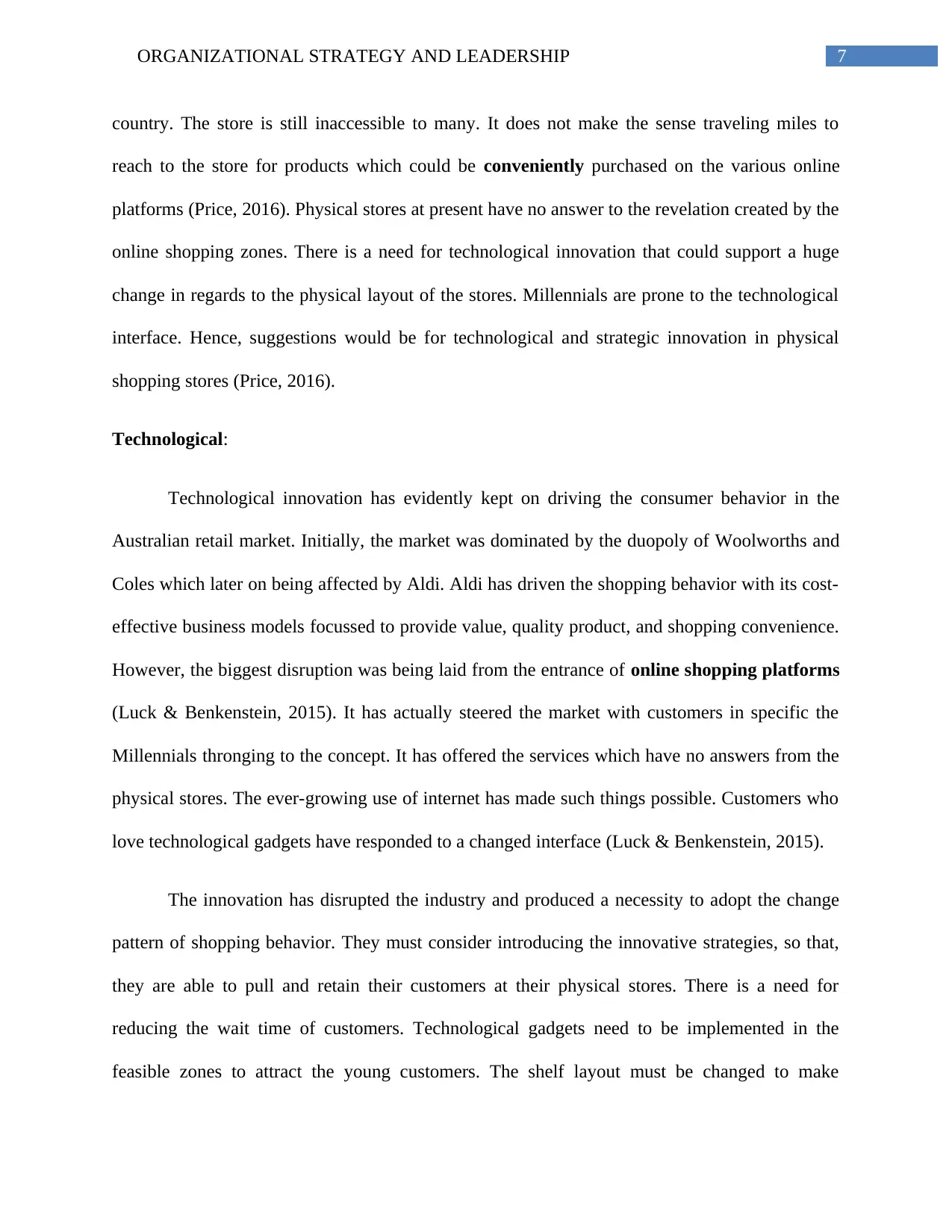
7ORGANIZATIONAL STRATEGY AND LEADERSHIP
country. The store is still inaccessible to many. It does not make the sense traveling miles to
reach to the store for products which could be conveniently purchased on the various online
platforms (Price, 2016). Physical stores at present have no answer to the revelation created by the
online shopping zones. There is a need for technological innovation that could support a huge
change in regards to the physical layout of the stores. Millennials are prone to the technological
interface. Hence, suggestions would be for technological and strategic innovation in physical
shopping stores (Price, 2016).
Technological:
Technological innovation has evidently kept on driving the consumer behavior in the
Australian retail market. Initially, the market was dominated by the duopoly of Woolworths and
Coles which later on being affected by Aldi. Aldi has driven the shopping behavior with its cost-
effective business models focussed to provide value, quality product, and shopping convenience.
However, the biggest disruption was being laid from the entrance of online shopping platforms
(Luck & Benkenstein, 2015). It has actually steered the market with customers in specific the
Millennials thronging to the concept. It has offered the services which have no answers from the
physical stores. The ever-growing use of internet has made such things possible. Customers who
love technological gadgets have responded to a changed interface (Luck & Benkenstein, 2015).
The innovation has disrupted the industry and produced a necessity to adopt the change
pattern of shopping behavior. They must consider introducing the innovative strategies, so that,
they are able to pull and retain their customers at their physical stores. There is a need for
reducing the wait time of customers. Technological gadgets need to be implemented in the
feasible zones to attract the young customers. The shelf layout must be changed to make
country. The store is still inaccessible to many. It does not make the sense traveling miles to
reach to the store for products which could be conveniently purchased on the various online
platforms (Price, 2016). Physical stores at present have no answer to the revelation created by the
online shopping zones. There is a need for technological innovation that could support a huge
change in regards to the physical layout of the stores. Millennials are prone to the technological
interface. Hence, suggestions would be for technological and strategic innovation in physical
shopping stores (Price, 2016).
Technological:
Technological innovation has evidently kept on driving the consumer behavior in the
Australian retail market. Initially, the market was dominated by the duopoly of Woolworths and
Coles which later on being affected by Aldi. Aldi has driven the shopping behavior with its cost-
effective business models focussed to provide value, quality product, and shopping convenience.
However, the biggest disruption was being laid from the entrance of online shopping platforms
(Luck & Benkenstein, 2015). It has actually steered the market with customers in specific the
Millennials thronging to the concept. It has offered the services which have no answers from the
physical stores. The ever-growing use of internet has made such things possible. Customers who
love technological gadgets have responded to a changed interface (Luck & Benkenstein, 2015).
The innovation has disrupted the industry and produced a necessity to adopt the change
pattern of shopping behavior. They must consider introducing the innovative strategies, so that,
they are able to pull and retain their customers at their physical stores. There is a need for
reducing the wait time of customers. Technological gadgets need to be implemented in the
feasible zones to attract the young customers. The shelf layout must be changed to make
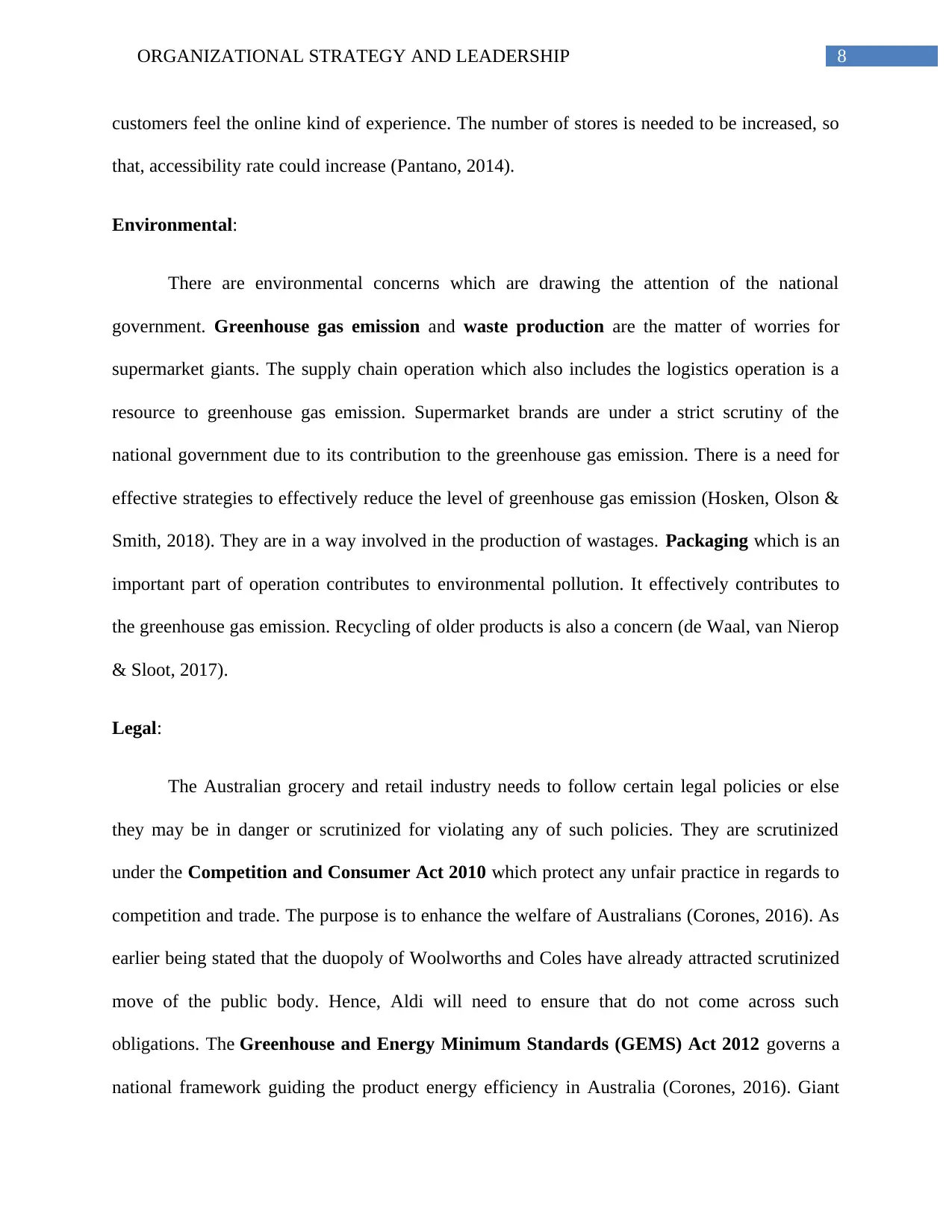
8ORGANIZATIONAL STRATEGY AND LEADERSHIP
customers feel the online kind of experience. The number of stores is needed to be increased, so
that, accessibility rate could increase (Pantano, 2014).
Environmental:
There are environmental concerns which are drawing the attention of the national
government. Greenhouse gas emission and waste production are the matter of worries for
supermarket giants. The supply chain operation which also includes the logistics operation is a
resource to greenhouse gas emission. Supermarket brands are under a strict scrutiny of the
national government due to its contribution to the greenhouse gas emission. There is a need for
effective strategies to effectively reduce the level of greenhouse gas emission (Hosken, Olson &
Smith, 2018). They are in a way involved in the production of wastages. Packaging which is an
important part of operation contributes to environmental pollution. It effectively contributes to
the greenhouse gas emission. Recycling of older products is also a concern (de Waal, van Nierop
& Sloot, 2017).
Legal:
The Australian grocery and retail industry needs to follow certain legal policies or else
they may be in danger or scrutinized for violating any of such policies. They are scrutinized
under the Competition and Consumer Act 2010 which protect any unfair practice in regards to
competition and trade. The purpose is to enhance the welfare of Australians (Corones, 2016). As
earlier being stated that the duopoly of Woolworths and Coles have already attracted scrutinized
move of the public body. Hence, Aldi will need to ensure that do not come across such
obligations. The Greenhouse and Energy Minimum Standards (GEMS) Act 2012 governs a
national framework guiding the product energy efficiency in Australia (Corones, 2016). Giant
customers feel the online kind of experience. The number of stores is needed to be increased, so
that, accessibility rate could increase (Pantano, 2014).
Environmental:
There are environmental concerns which are drawing the attention of the national
government. Greenhouse gas emission and waste production are the matter of worries for
supermarket giants. The supply chain operation which also includes the logistics operation is a
resource to greenhouse gas emission. Supermarket brands are under a strict scrutiny of the
national government due to its contribution to the greenhouse gas emission. There is a need for
effective strategies to effectively reduce the level of greenhouse gas emission (Hosken, Olson &
Smith, 2018). They are in a way involved in the production of wastages. Packaging which is an
important part of operation contributes to environmental pollution. It effectively contributes to
the greenhouse gas emission. Recycling of older products is also a concern (de Waal, van Nierop
& Sloot, 2017).
Legal:
The Australian grocery and retail industry needs to follow certain legal policies or else
they may be in danger or scrutinized for violating any of such policies. They are scrutinized
under the Competition and Consumer Act 2010 which protect any unfair practice in regards to
competition and trade. The purpose is to enhance the welfare of Australians (Corones, 2016). As
earlier being stated that the duopoly of Woolworths and Coles have already attracted scrutinized
move of the public body. Hence, Aldi will need to ensure that do not come across such
obligations. The Greenhouse and Energy Minimum Standards (GEMS) Act 2012 governs a
national framework guiding the product energy efficiency in Australia (Corones, 2016). Giant

9ORGANIZATIONAL STRATEGY AND LEADERSHIP
supermarket brands like Aldi may be required to continually deploy thoughts to remain safe from
any such obligation. This is also necessary to prove their image as a socially responsible firm.
Industry analysis:
Porter’s five forces analysis:
Threat of substitutes: (Low)
The Australian supermarket and grocery industry has witnessed a wide variety of stores
like convenience stores, specialty grocery stores, and farmer's markets. However, the market is
now reaching the saturation stage (Medlin & Ellegaard, 2015). Additionally, the technological
disruption does already exist in the form of online shopping platforms. The existing supermarket
giants like Woolworths, Coles, and Aldi can only consider improving the shopping interface
through incepting a few of technological innovations. Brands can improve the shopping
experience of their customers but, only through feasible technological interventions (Arup,
Beaton-Wells & Paul-Taylor, 2017). Hence, it appears as if there are no more scopes for a
substitute business.
Threat of new entrants: (High)
The sheer competition from online shopping giants has produced the necessity for few
modifications in the existing store format. Modifications need to be in regards to such as
improving the shopping interface, reducing the wait time for customers and increasing the
number of stores. Hence, firms with the effective business model may be a possibility. Lidl, for
example, has made a knocking entry in the Australian retail industry (Methner, Hamann &
supermarket brands like Aldi may be required to continually deploy thoughts to remain safe from
any such obligation. This is also necessary to prove their image as a socially responsible firm.
Industry analysis:
Porter’s five forces analysis:
Threat of substitutes: (Low)
The Australian supermarket and grocery industry has witnessed a wide variety of stores
like convenience stores, specialty grocery stores, and farmer's markets. However, the market is
now reaching the saturation stage (Medlin & Ellegaard, 2015). Additionally, the technological
disruption does already exist in the form of online shopping platforms. The existing supermarket
giants like Woolworths, Coles, and Aldi can only consider improving the shopping interface
through incepting a few of technological innovations. Brands can improve the shopping
experience of their customers but, only through feasible technological interventions (Arup,
Beaton-Wells & Paul-Taylor, 2017). Hence, it appears as if there are no more scopes for a
substitute business.
Threat of new entrants: (High)
The sheer competition from online shopping giants has produced the necessity for few
modifications in the existing store format. Modifications need to be in regards to such as
improving the shopping interface, reducing the wait time for customers and increasing the
number of stores. Hence, firms with the effective business model may be a possibility. Lidl, for
example, has made a knocking entry in the Australian retail industry (Methner, Hamann &
Secure Best Marks with AI Grader
Need help grading? Try our AI Grader for instant feedback on your assignments.
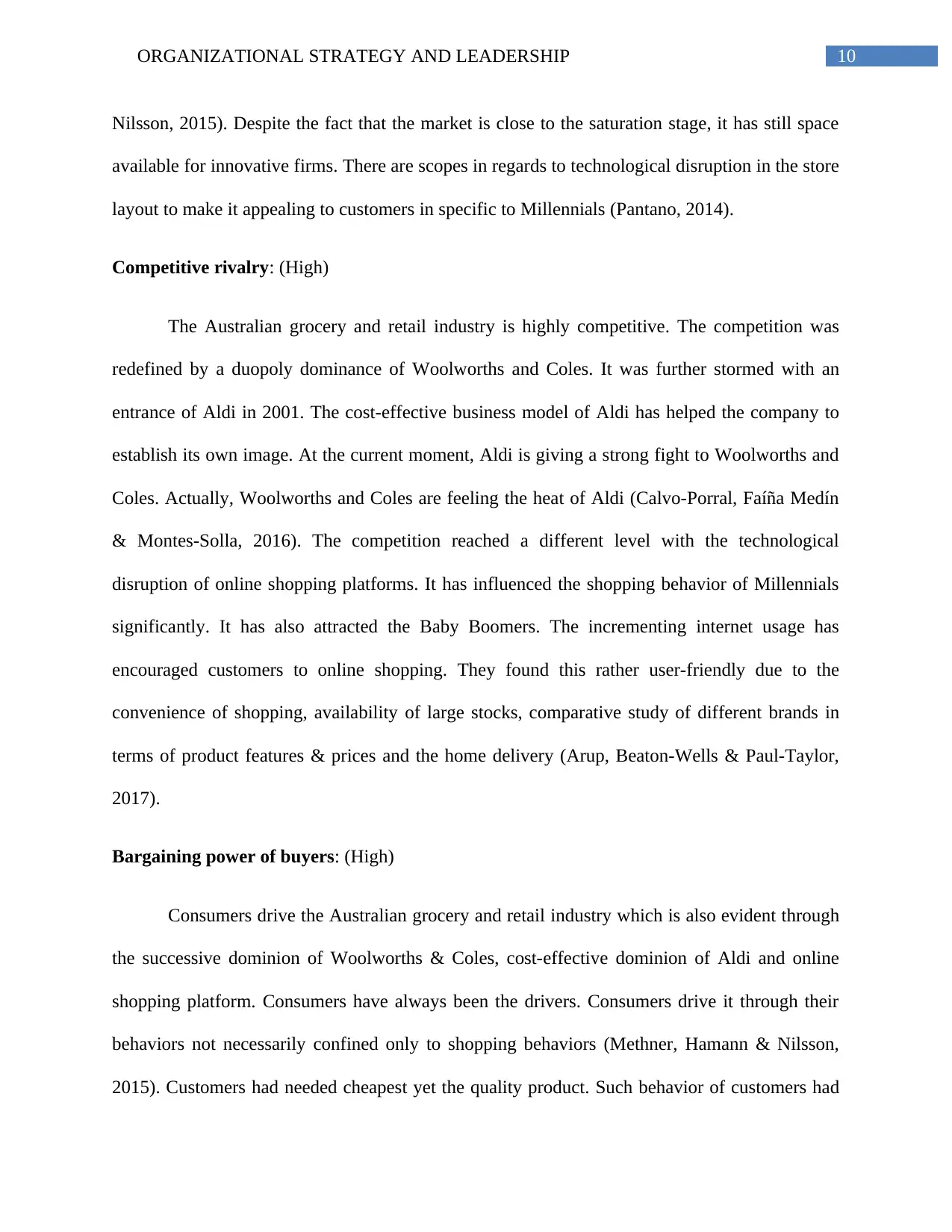
10ORGANIZATIONAL STRATEGY AND LEADERSHIP
Nilsson, 2015). Despite the fact that the market is close to the saturation stage, it has still space
available for innovative firms. There are scopes in regards to technological disruption in the store
layout to make it appealing to customers in specific to Millennials (Pantano, 2014).
Competitive rivalry: (High)
The Australian grocery and retail industry is highly competitive. The competition was
redefined by a duopoly dominance of Woolworths and Coles. It was further stormed with an
entrance of Aldi in 2001. The cost-effective business model of Aldi has helped the company to
establish its own image. At the current moment, Aldi is giving a strong fight to Woolworths and
Coles. Actually, Woolworths and Coles are feeling the heat of Aldi (Calvo-Porral, Faíña Medín
& Montes-Solla, 2016). The competition reached a different level with the technological
disruption of online shopping platforms. It has influenced the shopping behavior of Millennials
significantly. It has also attracted the Baby Boomers. The incrementing internet usage has
encouraged customers to online shopping. They found this rather user-friendly due to the
convenience of shopping, availability of large stocks, comparative study of different brands in
terms of product features & prices and the home delivery (Arup, Beaton-Wells & Paul-Taylor,
2017).
Bargaining power of buyers: (High)
Consumers drive the Australian grocery and retail industry which is also evident through
the successive dominion of Woolworths & Coles, cost-effective dominion of Aldi and online
shopping platform. Consumers have always been the drivers. Consumers drive it through their
behaviors not necessarily confined only to shopping behaviors (Methner, Hamann & Nilsson,
2015). Customers had needed cheapest yet the quality product. Such behavior of customers had
Nilsson, 2015). Despite the fact that the market is close to the saturation stage, it has still space
available for innovative firms. There are scopes in regards to technological disruption in the store
layout to make it appealing to customers in specific to Millennials (Pantano, 2014).
Competitive rivalry: (High)
The Australian grocery and retail industry is highly competitive. The competition was
redefined by a duopoly dominance of Woolworths and Coles. It was further stormed with an
entrance of Aldi in 2001. The cost-effective business model of Aldi has helped the company to
establish its own image. At the current moment, Aldi is giving a strong fight to Woolworths and
Coles. Actually, Woolworths and Coles are feeling the heat of Aldi (Calvo-Porral, Faíña Medín
& Montes-Solla, 2016). The competition reached a different level with the technological
disruption of online shopping platforms. It has influenced the shopping behavior of Millennials
significantly. It has also attracted the Baby Boomers. The incrementing internet usage has
encouraged customers to online shopping. They found this rather user-friendly due to the
convenience of shopping, availability of large stocks, comparative study of different brands in
terms of product features & prices and the home delivery (Arup, Beaton-Wells & Paul-Taylor,
2017).
Bargaining power of buyers: (High)
Consumers drive the Australian grocery and retail industry which is also evident through
the successive dominion of Woolworths & Coles, cost-effective dominion of Aldi and online
shopping platform. Consumers have always been the drivers. Consumers drive it through their
behaviors not necessarily confined only to shopping behaviors (Methner, Hamann & Nilsson,
2015). Customers had needed cheapest yet the quality product. Such behavior of customers had

11ORGANIZATIONAL STRATEGY AND LEADERSHIP
given space to discounted stores. When retailers have felt the necessity to provide a convenient
shopping experience they had come up with the convenient stores. Aldi had identified the need to
offer all those three elements such as value, quality product and shopping convenience under one
roof. Online shopping platforms can be regarded as an outcome of incrementing internet usage
(Calvo-Porral, Faíña Medín & Montes-Solla, 2016).
Bargaining power of suppliers: (Low)
The Australian supermarket brands have been able to manage an effective relationship
with suppliers. Hence, they had been able to manage it according to their needs. Till the time,
when duopoly of Woolworths and Coles had existed they had been dominating their relationship
with suppliers. They were the biggest buyers and hence, they had the advantage (Hosken, Olson
& Smith, 2018). Aldi, on the other hand, moved along a different line to manage an effective
relationship with suppliers. The first move was to reduce the number of stock keeping units
(SKUs). They had also offered a very limited range of products than Woolworths and Coles do.
In this way, Aldi was able to reduce the bargaining power of suppliers (de Waal, van Nierop &
Sloot, 2017). Few of the exclusive private-label brands were accountable for a 90% shelf space
payment (de Waal, van Nierop & Sloot, 2017). In this way, Aldi was able to reduce the cost of
production and also the bargaining power of suppliers.
Factors driving the industry towards a change:
Few factors are worth mentioning due to its impact on the Australian retail industry. The
Australian customer landscapes especially the Ethnic Australians and Millennials are shifting
towards a new direction. They want fresh, healthy and quality products from a resource other
than the online shopping platforms. They are well educated on the impact of business on the
given space to discounted stores. When retailers have felt the necessity to provide a convenient
shopping experience they had come up with the convenient stores. Aldi had identified the need to
offer all those three elements such as value, quality product and shopping convenience under one
roof. Online shopping platforms can be regarded as an outcome of incrementing internet usage
(Calvo-Porral, Faíña Medín & Montes-Solla, 2016).
Bargaining power of suppliers: (Low)
The Australian supermarket brands have been able to manage an effective relationship
with suppliers. Hence, they had been able to manage it according to their needs. Till the time,
when duopoly of Woolworths and Coles had existed they had been dominating their relationship
with suppliers. They were the biggest buyers and hence, they had the advantage (Hosken, Olson
& Smith, 2018). Aldi, on the other hand, moved along a different line to manage an effective
relationship with suppliers. The first move was to reduce the number of stock keeping units
(SKUs). They had also offered a very limited range of products than Woolworths and Coles do.
In this way, Aldi was able to reduce the bargaining power of suppliers (de Waal, van Nierop &
Sloot, 2017). Few of the exclusive private-label brands were accountable for a 90% shelf space
payment (de Waal, van Nierop & Sloot, 2017). In this way, Aldi was able to reduce the cost of
production and also the bargaining power of suppliers.
Factors driving the industry towards a change:
Few factors are worth mentioning due to its impact on the Australian retail industry. The
Australian customer landscapes especially the Ethnic Australians and Millennials are shifting
towards a new direction. They want fresh, healthy and quality products from a resource other
than the online shopping platforms. They are well educated on the impact of business on the
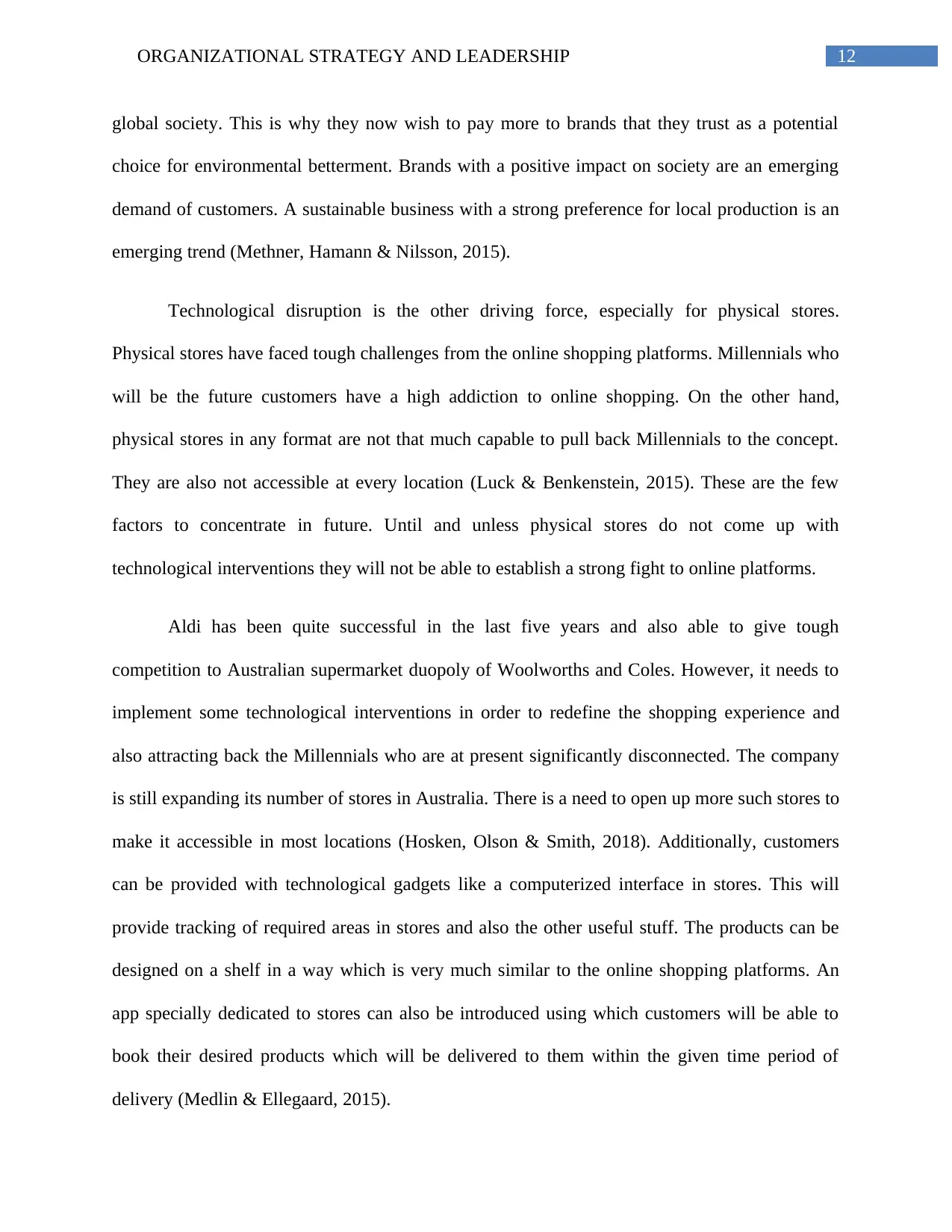
12ORGANIZATIONAL STRATEGY AND LEADERSHIP
global society. This is why they now wish to pay more to brands that they trust as a potential
choice for environmental betterment. Brands with a positive impact on society are an emerging
demand of customers. A sustainable business with a strong preference for local production is an
emerging trend (Methner, Hamann & Nilsson, 2015).
Technological disruption is the other driving force, especially for physical stores.
Physical stores have faced tough challenges from the online shopping platforms. Millennials who
will be the future customers have a high addiction to online shopping. On the other hand,
physical stores in any format are not that much capable to pull back Millennials to the concept.
They are also not accessible at every location (Luck & Benkenstein, 2015). These are the few
factors to concentrate in future. Until and unless physical stores do not come up with
technological interventions they will not be able to establish a strong fight to online platforms.
Aldi has been quite successful in the last five years and also able to give tough
competition to Australian supermarket duopoly of Woolworths and Coles. However, it needs to
implement some technological interventions in order to redefine the shopping experience and
also attracting back the Millennials who are at present significantly disconnected. The company
is still expanding its number of stores in Australia. There is a need to open up more such stores to
make it accessible in most locations (Hosken, Olson & Smith, 2018). Additionally, customers
can be provided with technological gadgets like a computerized interface in stores. This will
provide tracking of required areas in stores and also the other useful stuff. The products can be
designed on a shelf in a way which is very much similar to the online shopping platforms. An
app specially dedicated to stores can also be introduced using which customers will be able to
book their desired products which will be delivered to them within the given time period of
delivery (Medlin & Ellegaard, 2015).
global society. This is why they now wish to pay more to brands that they trust as a potential
choice for environmental betterment. Brands with a positive impact on society are an emerging
demand of customers. A sustainable business with a strong preference for local production is an
emerging trend (Methner, Hamann & Nilsson, 2015).
Technological disruption is the other driving force, especially for physical stores.
Physical stores have faced tough challenges from the online shopping platforms. Millennials who
will be the future customers have a high addiction to online shopping. On the other hand,
physical stores in any format are not that much capable to pull back Millennials to the concept.
They are also not accessible at every location (Luck & Benkenstein, 2015). These are the few
factors to concentrate in future. Until and unless physical stores do not come up with
technological interventions they will not be able to establish a strong fight to online platforms.
Aldi has been quite successful in the last five years and also able to give tough
competition to Australian supermarket duopoly of Woolworths and Coles. However, it needs to
implement some technological interventions in order to redefine the shopping experience and
also attracting back the Millennials who are at present significantly disconnected. The company
is still expanding its number of stores in Australia. There is a need to open up more such stores to
make it accessible in most locations (Hosken, Olson & Smith, 2018). Additionally, customers
can be provided with technological gadgets like a computerized interface in stores. This will
provide tracking of required areas in stores and also the other useful stuff. The products can be
designed on a shelf in a way which is very much similar to the online shopping platforms. An
app specially dedicated to stores can also be introduced using which customers will be able to
book their desired products which will be delivered to them within the given time period of
delivery (Medlin & Ellegaard, 2015).
Paraphrase This Document
Need a fresh take? Get an instant paraphrase of this document with our AI Paraphraser

13ORGANIZATIONAL STRATEGY AND LEADERSHIP
Effect of the change in the industry:
The first change which was for a socially responsible business may bring significant
changes to the shopping behaviors of customers. Customers especially those who are well-
informed of the societal values will look for going to the changed option. It means customer
loyalty will increase. This is actually necessary for a sustained business (de Waal, van Nierop &
Sloot, 2017).
Technological interventions that have been suggested to compete against the online
platforms may also produce necessary outcomes. Millennials may feel like visiting physical
stores if it is available to their desired location. The smart technology at stores like computer
interface can be a guiding experience for customers. The recommended app may also prove to be
an engaging experience. Customers, in particular, the Millennials will roam around the store with
the help of guidelines available on the computer interface. It is also time-effective as instant
information will be generated. Customers will not require roaming around the stores and
searching for their desired products. They will be to their desired location with just a slight work
on the interface (Borraz et al., 2014).
Millennials may be delighted also with this new experience and feel like using the service
again. The use of app may also give them an experience similar to the online shopping where
they can book their orders and get it delivered at their doorstep. It means that they are physically
viewing their products. Hence, they will have no doubts on whether the chosen product is exactly
the same as it looked like. This is quite possible in online shopping where it is very challenging
to judge a few things like color textures, designs, and a real look. However, if supermarket stores
like Aldi come up with the concept, customers will actually be able to judge products based on
Effect of the change in the industry:
The first change which was for a socially responsible business may bring significant
changes to the shopping behaviors of customers. Customers especially those who are well-
informed of the societal values will look for going to the changed option. It means customer
loyalty will increase. This is actually necessary for a sustained business (de Waal, van Nierop &
Sloot, 2017).
Technological interventions that have been suggested to compete against the online
platforms may also produce necessary outcomes. Millennials may feel like visiting physical
stores if it is available to their desired location. The smart technology at stores like computer
interface can be a guiding experience for customers. The recommended app may also prove to be
an engaging experience. Customers, in particular, the Millennials will roam around the store with
the help of guidelines available on the computer interface. It is also time-effective as instant
information will be generated. Customers will not require roaming around the stores and
searching for their desired products. They will be to their desired location with just a slight work
on the interface (Borraz et al., 2014).
Millennials may be delighted also with this new experience and feel like using the service
again. The use of app may also give them an experience similar to the online shopping where
they can book their orders and get it delivered at their doorstep. It means that they are physically
viewing their products. Hence, they will have no doubts on whether the chosen product is exactly
the same as it looked like. This is quite possible in online shopping where it is very challenging
to judge a few things like color textures, designs, and a real look. However, if supermarket stores
like Aldi come up with the concept, customers will actually be able to judge products based on
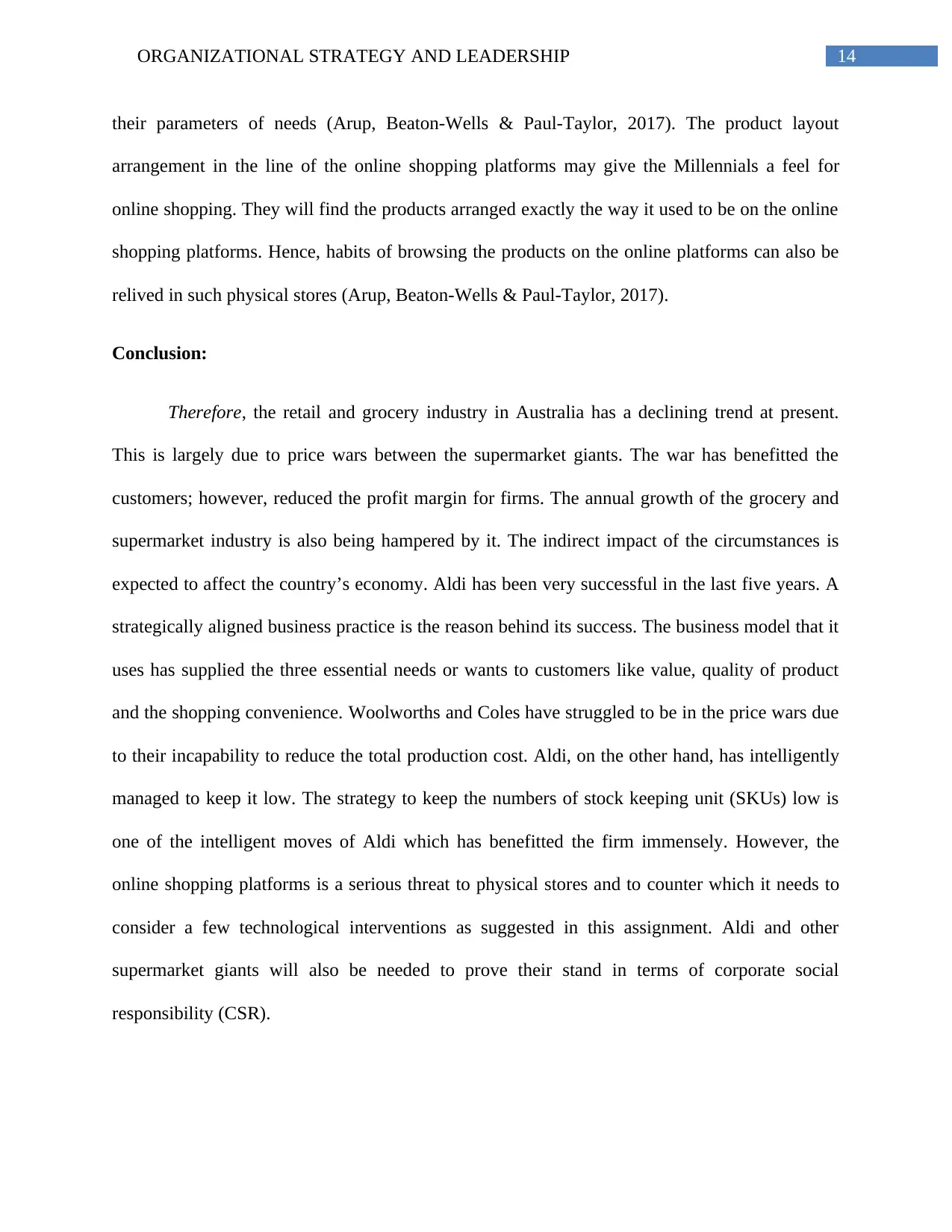
14ORGANIZATIONAL STRATEGY AND LEADERSHIP
their parameters of needs (Arup, Beaton-Wells & Paul-Taylor, 2017). The product layout
arrangement in the line of the online shopping platforms may give the Millennials a feel for
online shopping. They will find the products arranged exactly the way it used to be on the online
shopping platforms. Hence, habits of browsing the products on the online platforms can also be
relived in such physical stores (Arup, Beaton-Wells & Paul-Taylor, 2017).
Conclusion:
Therefore, the retail and grocery industry in Australia has a declining trend at present.
This is largely due to price wars between the supermarket giants. The war has benefitted the
customers; however, reduced the profit margin for firms. The annual growth of the grocery and
supermarket industry is also being hampered by it. The indirect impact of the circumstances is
expected to affect the country’s economy. Aldi has been very successful in the last five years. A
strategically aligned business practice is the reason behind its success. The business model that it
uses has supplied the three essential needs or wants to customers like value, quality of product
and the shopping convenience. Woolworths and Coles have struggled to be in the price wars due
to their incapability to reduce the total production cost. Aldi, on the other hand, has intelligently
managed to keep it low. The strategy to keep the numbers of stock keeping unit (SKUs) low is
one of the intelligent moves of Aldi which has benefitted the firm immensely. However, the
online shopping platforms is a serious threat to physical stores and to counter which it needs to
consider a few technological interventions as suggested in this assignment. Aldi and other
supermarket giants will also be needed to prove their stand in terms of corporate social
responsibility (CSR).
their parameters of needs (Arup, Beaton-Wells & Paul-Taylor, 2017). The product layout
arrangement in the line of the online shopping platforms may give the Millennials a feel for
online shopping. They will find the products arranged exactly the way it used to be on the online
shopping platforms. Hence, habits of browsing the products on the online platforms can also be
relived in such physical stores (Arup, Beaton-Wells & Paul-Taylor, 2017).
Conclusion:
Therefore, the retail and grocery industry in Australia has a declining trend at present.
This is largely due to price wars between the supermarket giants. The war has benefitted the
customers; however, reduced the profit margin for firms. The annual growth of the grocery and
supermarket industry is also being hampered by it. The indirect impact of the circumstances is
expected to affect the country’s economy. Aldi has been very successful in the last five years. A
strategically aligned business practice is the reason behind its success. The business model that it
uses has supplied the three essential needs or wants to customers like value, quality of product
and the shopping convenience. Woolworths and Coles have struggled to be in the price wars due
to their incapability to reduce the total production cost. Aldi, on the other hand, has intelligently
managed to keep it low. The strategy to keep the numbers of stock keeping unit (SKUs) low is
one of the intelligent moves of Aldi which has benefitted the firm immensely. However, the
online shopping platforms is a serious threat to physical stores and to counter which it needs to
consider a few technological interventions as suggested in this assignment. Aldi and other
supermarket giants will also be needed to prove their stand in terms of corporate social
responsibility (CSR).
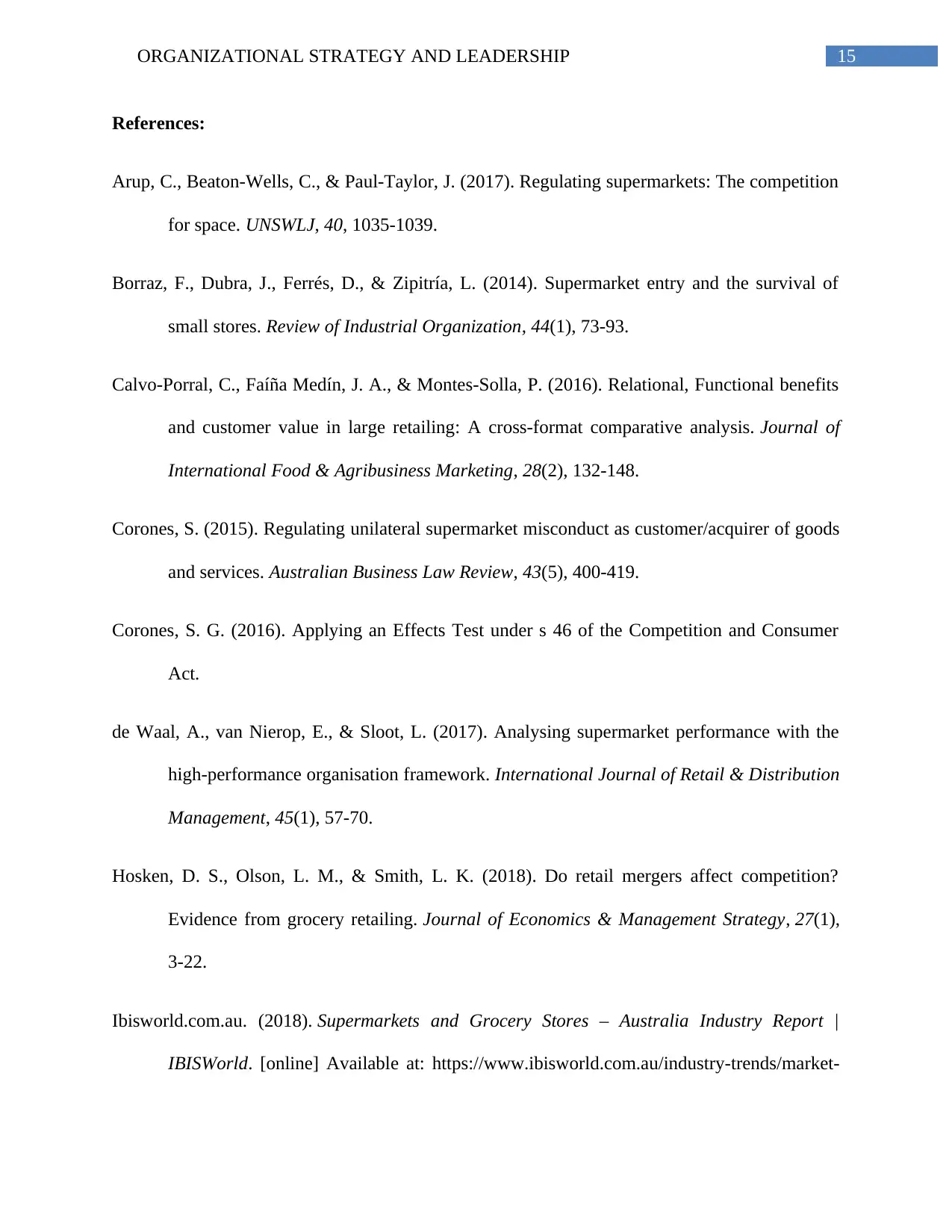
15ORGANIZATIONAL STRATEGY AND LEADERSHIP
References:
Arup, C., Beaton-Wells, C., & Paul-Taylor, J. (2017). Regulating supermarkets: The competition
for space. UNSWLJ, 40, 1035-1039.
Borraz, F., Dubra, J., Ferrés, D., & Zipitría, L. (2014). Supermarket entry and the survival of
small stores. Review of Industrial Organization, 44(1), 73-93.
Calvo-Porral, C., Faíña Medín, J. A., & Montes-Solla, P. (2016). Relational, Functional benefits
and customer value in large retailing: A cross-format comparative analysis. Journal of
International Food & Agribusiness Marketing, 28(2), 132-148.
Corones, S. (2015). Regulating unilateral supermarket misconduct as customer/acquirer of goods
and services. Australian Business Law Review, 43(5), 400-419.
Corones, S. G. (2016). Applying an Effects Test under s 46 of the Competition and Consumer
Act.
de Waal, A., van Nierop, E., & Sloot, L. (2017). Analysing supermarket performance with the
high-performance organisation framework. International Journal of Retail & Distribution
Management, 45(1), 57-70.
Hosken, D. S., Olson, L. M., & Smith, L. K. (2018). Do retail mergers affect competition?
Evidence from grocery retailing. Journal of Economics & Management Strategy, 27(1),
3-22.
Ibisworld.com.au. (2018). Supermarkets and Grocery Stores – Australia Industry Report |
IBISWorld. [online] Available at: https://www.ibisworld.com.au/industry-trends/market-
References:
Arup, C., Beaton-Wells, C., & Paul-Taylor, J. (2017). Regulating supermarkets: The competition
for space. UNSWLJ, 40, 1035-1039.
Borraz, F., Dubra, J., Ferrés, D., & Zipitría, L. (2014). Supermarket entry and the survival of
small stores. Review of Industrial Organization, 44(1), 73-93.
Calvo-Porral, C., Faíña Medín, J. A., & Montes-Solla, P. (2016). Relational, Functional benefits
and customer value in large retailing: A cross-format comparative analysis. Journal of
International Food & Agribusiness Marketing, 28(2), 132-148.
Corones, S. (2015). Regulating unilateral supermarket misconduct as customer/acquirer of goods
and services. Australian Business Law Review, 43(5), 400-419.
Corones, S. G. (2016). Applying an Effects Test under s 46 of the Competition and Consumer
Act.
de Waal, A., van Nierop, E., & Sloot, L. (2017). Analysing supermarket performance with the
high-performance organisation framework. International Journal of Retail & Distribution
Management, 45(1), 57-70.
Hosken, D. S., Olson, L. M., & Smith, L. K. (2018). Do retail mergers affect competition?
Evidence from grocery retailing. Journal of Economics & Management Strategy, 27(1),
3-22.
Ibisworld.com.au. (2018). Supermarkets and Grocery Stores – Australia Industry Report |
IBISWorld. [online] Available at: https://www.ibisworld.com.au/industry-trends/market-
Secure Best Marks with AI Grader
Need help grading? Try our AI Grader for instant feedback on your assignments.
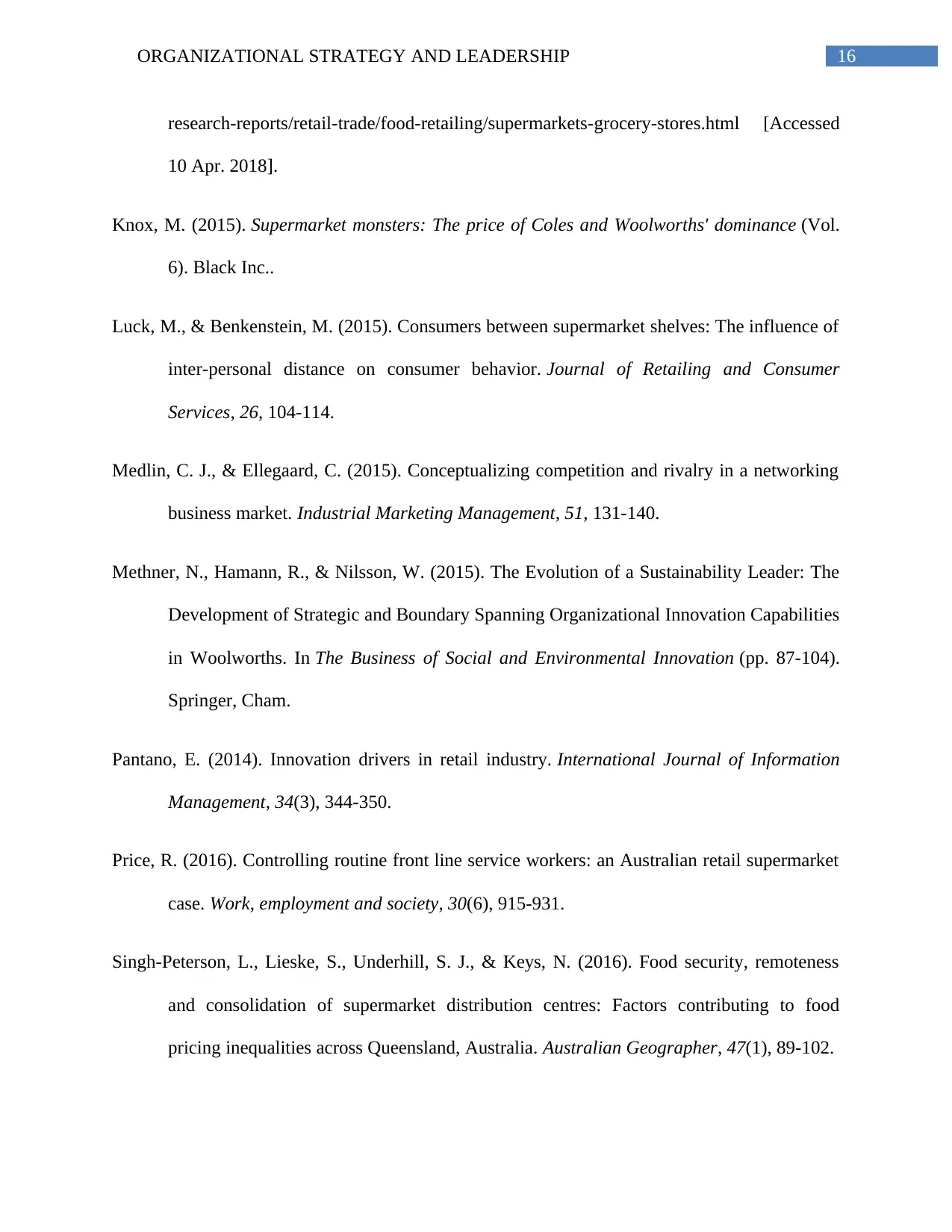
16ORGANIZATIONAL STRATEGY AND LEADERSHIP
research-reports/retail-trade/food-retailing/supermarkets-grocery-stores.html [Accessed
10 Apr. 2018].
Knox, M. (2015). Supermarket monsters: The price of Coles and Woolworths' dominance (Vol.
6). Black Inc..
Luck, M., & Benkenstein, M. (2015). Consumers between supermarket shelves: The influence of
inter-personal distance on consumer behavior. Journal of Retailing and Consumer
Services, 26, 104-114.
Medlin, C. J., & Ellegaard, C. (2015). Conceptualizing competition and rivalry in a networking
business market. Industrial Marketing Management, 51, 131-140.
Methner, N., Hamann, R., & Nilsson, W. (2015). The Evolution of a Sustainability Leader: The
Development of Strategic and Boundary Spanning Organizational Innovation Capabilities
in Woolworths. In The Business of Social and Environmental Innovation (pp. 87-104).
Springer, Cham.
Pantano, E. (2014). Innovation drivers in retail industry. International Journal of Information
Management, 34(3), 344-350.
Price, R. (2016). Controlling routine front line service workers: an Australian retail supermarket
case. Work, employment and society, 30(6), 915-931.
Singh-Peterson, L., Lieske, S., Underhill, S. J., & Keys, N. (2016). Food security, remoteness
and consolidation of supermarket distribution centres: Factors contributing to food
pricing inequalities across Queensland, Australia. Australian Geographer, 47(1), 89-102.
research-reports/retail-trade/food-retailing/supermarkets-grocery-stores.html [Accessed
10 Apr. 2018].
Knox, M. (2015). Supermarket monsters: The price of Coles and Woolworths' dominance (Vol.
6). Black Inc..
Luck, M., & Benkenstein, M. (2015). Consumers between supermarket shelves: The influence of
inter-personal distance on consumer behavior. Journal of Retailing and Consumer
Services, 26, 104-114.
Medlin, C. J., & Ellegaard, C. (2015). Conceptualizing competition and rivalry in a networking
business market. Industrial Marketing Management, 51, 131-140.
Methner, N., Hamann, R., & Nilsson, W. (2015). The Evolution of a Sustainability Leader: The
Development of Strategic and Boundary Spanning Organizational Innovation Capabilities
in Woolworths. In The Business of Social and Environmental Innovation (pp. 87-104).
Springer, Cham.
Pantano, E. (2014). Innovation drivers in retail industry. International Journal of Information
Management, 34(3), 344-350.
Price, R. (2016). Controlling routine front line service workers: an Australian retail supermarket
case. Work, employment and society, 30(6), 915-931.
Singh-Peterson, L., Lieske, S., Underhill, S. J., & Keys, N. (2016). Food security, remoteness
and consolidation of supermarket distribution centres: Factors contributing to food
pricing inequalities across Queensland, Australia. Australian Geographer, 47(1), 89-102.
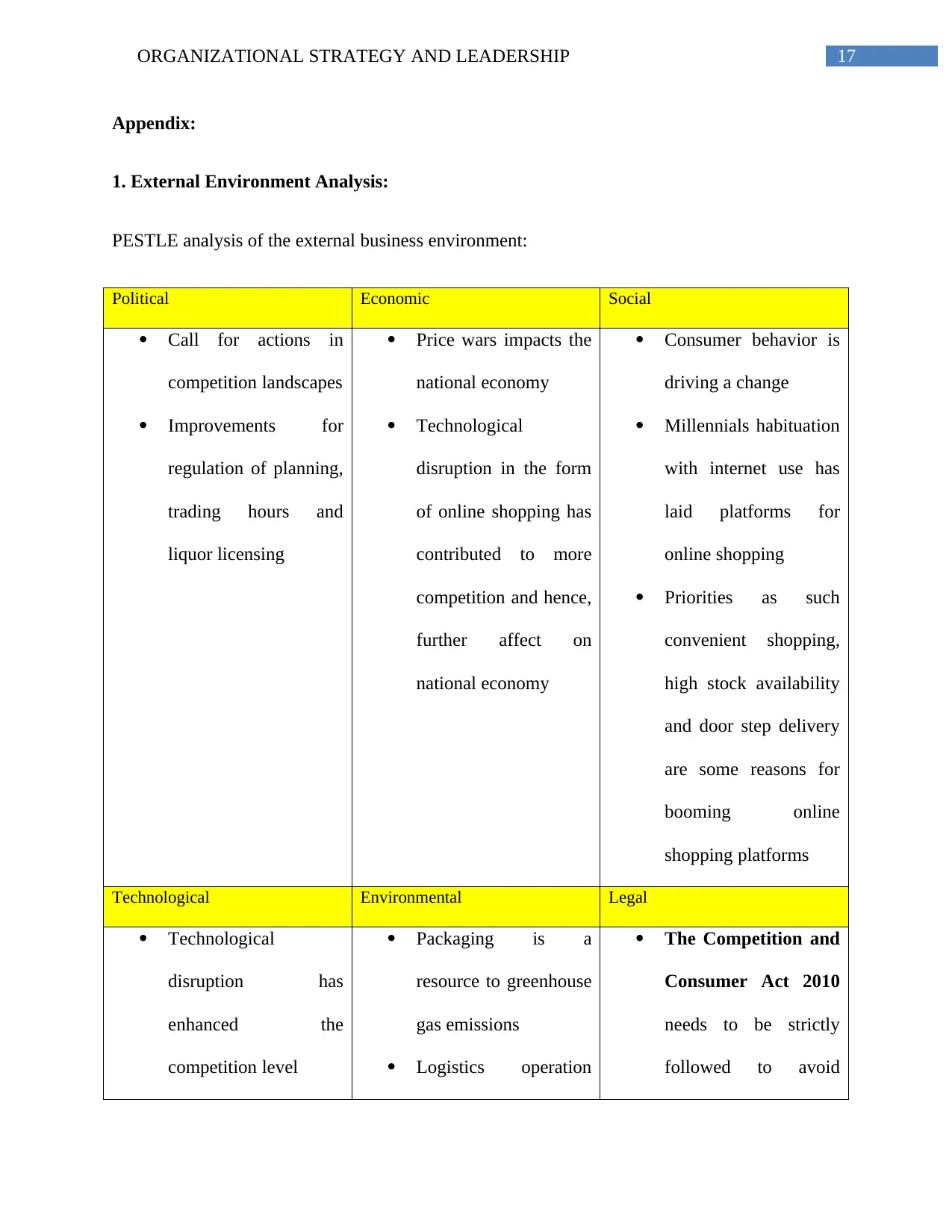
17ORGANIZATIONAL STRATEGY AND LEADERSHIP
Appendix:
1. External Environment Analysis:
PESTLE analysis of the external business environment:
Political Economic Social
Call for actions in
competition landscapes
Improvements for
regulation of planning,
trading hours and
liquor licensing
Price wars impacts the
national economy
Technological
disruption in the form
of online shopping has
contributed to more
competition and hence,
further affect on
national economy
Consumer behavior is
driving a change
Millennials habituation
with internet use has
laid platforms for
online shopping
Priorities as such
convenient shopping,
high stock availability
and door step delivery
are some reasons for
booming online
shopping platforms
Technological Environmental Legal
Technological
disruption has
enhanced the
competition level
Packaging is a
resource to greenhouse
gas emissions
Logistics operation
The Competition and
Consumer Act 2010
needs to be strictly
followed to avoid
Appendix:
1. External Environment Analysis:
PESTLE analysis of the external business environment:
Political Economic Social
Call for actions in
competition landscapes
Improvements for
regulation of planning,
trading hours and
liquor licensing
Price wars impacts the
national economy
Technological
disruption in the form
of online shopping has
contributed to more
competition and hence,
further affect on
national economy
Consumer behavior is
driving a change
Millennials habituation
with internet use has
laid platforms for
online shopping
Priorities as such
convenient shopping,
high stock availability
and door step delivery
are some reasons for
booming online
shopping platforms
Technological Environmental Legal
Technological
disruption has
enhanced the
competition level
Packaging is a
resource to greenhouse
gas emissions
Logistics operation
The Competition and
Consumer Act 2010
needs to be strictly
followed to avoid

18ORGANIZATIONAL STRATEGY AND LEADERSHIP
Online platforms have
outplayed physical
stores in terms of
pulling the Millennials
Technological
interventions such as
producing a smart
experience at stores
will now be key to
competency of
physical stores
used for supply chain
operations is another
resource to greenhouse
gas emission
Supermarket firms as
such Aldi need to take
efficient strategies to
avoid criticism
criticizing
consequences
The Greenhouse and
Energy Minimum
Standards (GEMS)
Act 2012 must be
complied to reduce the
greenhouse gas
emission
Online platforms have
outplayed physical
stores in terms of
pulling the Millennials
Technological
interventions such as
producing a smart
experience at stores
will now be key to
competency of
physical stores
used for supply chain
operations is another
resource to greenhouse
gas emission
Supermarket firms as
such Aldi need to take
efficient strategies to
avoid criticism
criticizing
consequences
The Greenhouse and
Energy Minimum
Standards (GEMS)
Act 2012 must be
complied to reduce the
greenhouse gas
emission
Paraphrase This Document
Need a fresh take? Get an instant paraphrase of this document with our AI Paraphraser
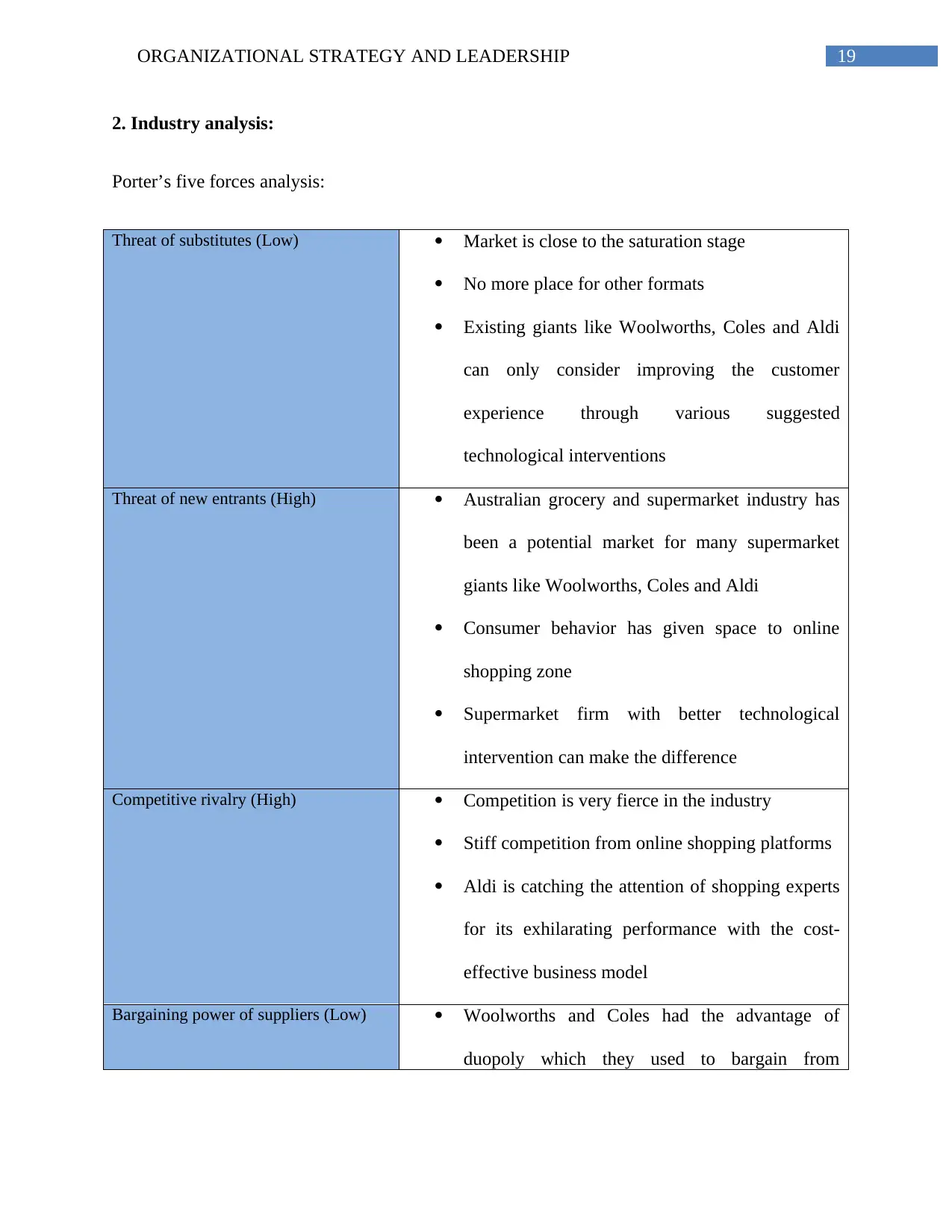
19ORGANIZATIONAL STRATEGY AND LEADERSHIP
2. Industry analysis:
Porter’s five forces analysis:
Threat of substitutes (Low) Market is close to the saturation stage
No more place for other formats
Existing giants like Woolworths, Coles and Aldi
can only consider improving the customer
experience through various suggested
technological interventions
Threat of new entrants (High) Australian grocery and supermarket industry has
been a potential market for many supermarket
giants like Woolworths, Coles and Aldi
Consumer behavior has given space to online
shopping zone
Supermarket firm with better technological
intervention can make the difference
Competitive rivalry (High) Competition is very fierce in the industry
Stiff competition from online shopping platforms
Aldi is catching the attention of shopping experts
for its exhilarating performance with the cost-
effective business model
Bargaining power of suppliers (Low) Woolworths and Coles had the advantage of
duopoly which they used to bargain from
2. Industry analysis:
Porter’s five forces analysis:
Threat of substitutes (Low) Market is close to the saturation stage
No more place for other formats
Existing giants like Woolworths, Coles and Aldi
can only consider improving the customer
experience through various suggested
technological interventions
Threat of new entrants (High) Australian grocery and supermarket industry has
been a potential market for many supermarket
giants like Woolworths, Coles and Aldi
Consumer behavior has given space to online
shopping zone
Supermarket firm with better technological
intervention can make the difference
Competitive rivalry (High) Competition is very fierce in the industry
Stiff competition from online shopping platforms
Aldi is catching the attention of shopping experts
for its exhilarating performance with the cost-
effective business model
Bargaining power of suppliers (Low) Woolworths and Coles had the advantage of
duopoly which they used to bargain from

20ORGANIZATIONAL STRATEGY AND LEADERSHIP
suppliers
Aldi with its effective business model has reduced
the affect of suppliers and hence, the total cost of
production
Bargaining power of customers (High) Customers have driven the market every time
Firms have kept on identifying the potential
choices and accordingly introduced the
innovation
Woolworths and Coles had introduced concept
like convenience and the discounted stores
Aldi has introduced a cost-effective business
model that helped the company to produce
attractive offers to customers
suppliers
Aldi with its effective business model has reduced
the affect of suppliers and hence, the total cost of
production
Bargaining power of customers (High) Customers have driven the market every time
Firms have kept on identifying the potential
choices and accordingly introduced the
innovation
Woolworths and Coles had introduced concept
like convenience and the discounted stores
Aldi has introduced a cost-effective business
model that helped the company to produce
attractive offers to customers
1 out of 21
Related Documents
Your All-in-One AI-Powered Toolkit for Academic Success.
+13062052269
info@desklib.com
Available 24*7 on WhatsApp / Email
![[object Object]](/_next/static/media/star-bottom.7253800d.svg)
Unlock your academic potential
© 2024 | Zucol Services PVT LTD | All rights reserved.





